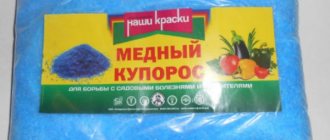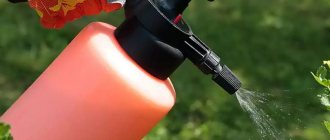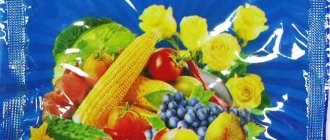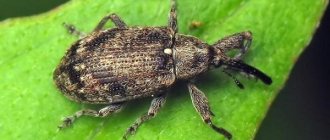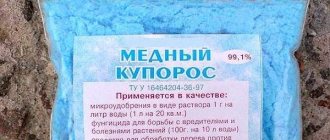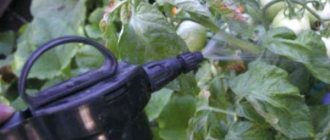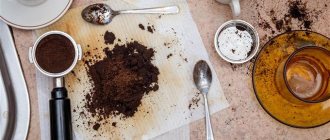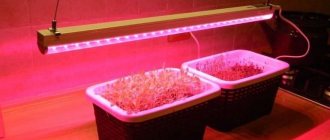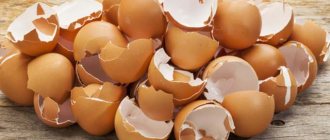Every gardener and gardener uses copper-containing preparations to protect their plants from rotting, diseases and pests. It is almost impossible to do without them. Therefore, plants are treated with solutions twice: before the buds open and the flowering phase begins, and twice more, in the autumn after the leaves fall. Thanks to copper, which is part of liquid mixtures, it is possible to prevent healthy crops, as well as treat damaged ones.
In the article we will provide information about what copper sulfate and Bordeaux mixture are, where and when to use solutions, give recommendations for diluting solutions and the dose of their use, and introduce safety rules when working with toxic substances.
Copper sulfate - what is this substance?
Copper sulfate is an active hygroscopic powder in the form of blue-blue crystals. It contains 980 g/kg copper sulfate. In an aqueous solution, it can protect trees, berries, grapes, vegetables and flowers from diseases for 30 days. After spraying, copper ions come into contact with a bacterial or fungal cell and inhibit lipoprotein and enzyme complexes in it. In this case, the protoplasm changes irreversibly and nonspecific denaturation of proteins occurs.
In other words, copper sulfate for plants is 5-hydrate 2-valent copper sulfate - CuSO4x5H2O. This product should not be handled carelessly.
Important to remember! Copper sulfate powder is classified as a class 3 hazardous chemical. It has a toxic effect when it comes into contact with a person’s mucous membranes or inside. The lethal dose of a 5% solution is 30-50 ml. If you do not take precautions when working with copper-containing liquid, it can penetrate the skin through the glands when sweat is reabsorbed.
Proper use of the chemical does not lead to long-term unwanted and side effects, since it does not have a cumulative effect, but only biocidal and fungicidal . The substance is not resistant to harmful objects, that is, it is not addictive and does not increase their resistance, so the powder is often used to combat mold. In addition, Cu (II) ions are a copper-containing microfertilizer, which promotes the synthesis of phytohormones in plants.
Cooking rules
So, we are preparing a 1% solution, which means you need to take 100 g per 10 liters of water. If you need to make a 3% solution, then the amount of vitriol increases to 300 g per 10 liters of water.
- 100 g of blue copper sulfate powder is poured into a container.
- First pour a small amount (about 500 ml) of moderately hot water. The water temperature should be about 50 degrees. The substance dissolves poorly in water at room temperature, and the solution turns out cloudy.
- The powder is allowed to dissolve slightly by rotating the container in a circle and left to stand for a while.
- Then pour out the remaining water (9.5 l) and stir well. The water should also be hot.
- You can prepare the solution in a water bath. But you should absolutely not heat the container directly on the stove or gas burner.
- It is best to dissolve copper sulfate in glass, enamel or plastic containers. Metal (iron or galvanized) containers cannot be taken - oxidation will occur.
- Do not prepare vitriol solution in the kitchen or near food products. The best thing is to go out into the garden and plant there.
- When preparing the solution, you should wear gloves and a protective mask, and when spraying trees, put on a plastic raincoat.
- When spraying, there should be no pets, children, or people nearby.
- Avoid contact of the solution with the eyes. And in case of contact, immediately rinse them with clean water.
- It is unacceptable to take the solution orally. But if this happens, it is recommended to drink 2-3 raw eggs or 300-500 ml of milk and call an ambulance. Drinking potassium permanganate or plain water in large quantities is useless.
Where is copper sulfate used?
What is liquid copper sulfate used for?
- to protect plants from diseases such as ascochyta blight, anthracnose, alternaria blight, moniliosis, clasterosporiosis, scab, coccomycosis, grape mildew, septoria or white spot, phyllostictosis, downy mildew, rust, curl, late blight and others;
- as a foliar feeding for copper deficiency in plantings on acidic sandy and peat soils;
- for spring and summer soil disinfection, while solutions are not used before winter to prevent oversaturation of the soil with copper ions;
- for wooden structures as an antiseptic against rot and mold.
Pathogens sensitive to copper-containing fungicides
Copper sulfate and mixtures based on it cope well with the following plant diseases:
- peronosporosis;
- coccomycosis;
- moniliosis;
- late blight;
- cercospora;
- scab;
- different types of spots;
- rust;
- septoria;
- anthracnose;
- ascochyta;
- powdery mildew.
At the same time, copper sulfate has a poisonous effect on psyllids, aphids, caterpillars and many other insects. A number of publications also mention the effectiveness of copper sulfate against spider mites.
Copper sulfate is suitable for spraying pome and stone fruit crops, currants, gooseberries, grapes, tomatoes, cucumbers, beets, potatoes, onions, raspberries.
Chemical dilution
How to prepare a 1% solution of liquid copper sulfate:
- for 10 liters of liquid – 100 g;
- per 1 liter of liquid – 10 g.
First you need to dilute the powder for the working solution in 500-700 ml of heated water to 40-50°C in a plastic bucket. After the copper sulfate is dissolved, the rest of the water is added.
Important. Metal buckets should not be used, and the solution should be filtered through a nylon filter before pouring into the sprayer.
Each season provides different purposes for processing plants, since copper sulfate can be diluted with a concentration of 3 degrees. Prepare the solution:
- Burning out - 3-5% preparation: water - 10 l, powder - 300-500 g. The mixture is used to disinfect the ground on the site or fight mold on building structures. The land is taken out of agricultural use for 12 months after cultivation.
- Therapeutic and prophylactic – 0.5-1%. Add 50-100 g of powder to 10 liters of water. Spray and treat wounds on trunks and branches, destroy fungi and pests, as indicated above.
- Feeding, fertilizing and prophylactic – 0.2-0.3%. For 10 liters of water – 2-3 g of powder. The treatment is used for symptoms of copper starvation: chlorosis of leaves, curling of shoot tips, intensive tillering without shoot growth and for the sake of prevention.
From the prepared 10% masterbatch, you can dilute the solutions specified in paragraphs. 2 and 3. The masterbatch can be stored for a long time in a dark place in a container with a well-closed lid .
Processing garden crops in summer
In hot weather, the following activities are recommended:
- Spraying. For this procedure, shrubs and trees are treated with a solution of 0.5-1% concentration if there are clear signs of any diseases.
- Watering. Potatoes and tomatoes should be fertilized unscheduled in order to prevent late blight and copper starvation, using a 0.2% solution at an irrigation rate of 2 liters per 1 square meter. Repeated treatment, if necessary, is carried out after 2-4 weeks.
- Treatment of wounds on fruit trees. This procedure is carried out with a composition of 1%.
- Treatment of wounds of bushes. For this activity you will need a solution with a concentration of 0.5%.
You need to know not only how vitriol is diluted for spraying, but also that the use of such an event is unacceptable during flowering crops. In autumn, preventive treatment of plants is carried out. This activity is carried out after collecting the leaves. Vitriol for such purposes is simply irreplaceable.
Bordeaux liquid
If copper sulfate is dissolved in water with lime, you get Bordeaux mixture. They sell a 3% mixture of chemicals in ready-made bags, where copper sulfate is 300 g and lime is 400 g. To dilute a 1% concentration, you will need 100 g of each component. Copper in the mixture plays the role of poison, and lime acts as a neutralizer. The solution is used immediately after dilution; if it is stored for a day, then add it to a 10-liter bucket with a mixture of sugar - 5 g.
Treat with Bordeaux mixture (3%) once before buds appear, 3-4 times during the growing season (1%). The validity period of the liquid is 10-14 days, after which subsequent treatment begins.
The mixture is applied to plants in the following quantities:
- for fruit and berry trees, deciduous and coniferous, large shrubs - 15-20 l/100 m²;
- for medium shrubs and grapes - 10-15 l/100 m²;
- for small bushes: potatoes, strawberries – 5-10 l/100 m²;
- for large trees with external signs of fungi - 10-15 liters of mixture (1%) per tree.
Using Bordeaux mixture, you can treat and prevent diseases of various plants and improve the health of your garden plot and vegetable beds.
How to use solutions in the garden and indoors
Instructions for using copper sulfate in the garden:
- Disinfect open ground or soil in a greenhouse 8-10 days before planting seedlings or seeds with a 3% solution: 30 g of powder per 1 liter of water. This remedy can protect potatoes from late blight.
- The fleshy root system of tuberous plants or bulbs is placed in a 1% mixture for 3 minutes, then washed and air dried.
- Indoor plants are protected from diseases with a sky-blue solution: take 1 tsp per 2 liters of water. powder without a slide. The mixture is poured under the root or sprayed on the leaves.
- Apple trees, pears, quince. Treatment of pome trees with copper sulfate is carried out for phyllosticosis and other spotting, scab, moniliosis, and drying out. For 10 liters of liquid – 100 g of the drug. The trees are treated for the first time before the buds open and 2-5 liters of the mixture are used for 1 tree. Repeat the treatment half a month before harvesting.
Copper sulfate for stone fruit trees is diluted for treatment of clasterosporosis, coccomycosis and other spots, moniliosis, leaf curl with a solution: water - 10 l, powder - 50-75 g. Sprayed for the first time in early spring before buds open and spend on the tree - 2-3 l mixture.
All types of currants and gooseberries are sprayed for the first time in early spring before the buds open and 1.5 liters of the mixture are used per bush: water 10 liters, powder – 50-75 g.
Vegetable processing:
- Before planting, potato tubers are placed in a net and dipped against late blight in the following solution: 2 g of powder per 10 liters of water.
- Vegetables are sprayed when spotting appears, for example, on cucumbers (ascochyta blight) with a 0.5% solution of urea (10 g) and vitriol (5 g) in water - 10 liters. Spray 2 times with an interval of 7-8 days.
- Melon plants: pumpkins, zucchini, melons, watermelons, cucumbers are sprayed 5 days before harvest.
In order to prevent root rot in melon plants, which can be seen by wilting of the bushes on hot days, yellowing of the leaves, dying off of the ovaries, and stopping the growth of seedlings, you need to treat the bushes with the following solution: add 1 tsp per 10 liters of water. copper sulfate, zinc sulfate and 1 tbsp. l. superphosphate. Use a freshly prepared solution at the rate of 5 l/m² of soil. Save vegetables and flowers from blackleg and fusarium with a solution: water - 10 l, preparation - 5 g.
About tomatoes
Tomatoes suffer from late blight, but their leaves are sensitive to copper. To avoid burns, you need a 0.2% solution of copper-soap emulsion: mix grated laundry soap - 200 g with hot water, separately dilute copper sulfate - 20 g in a glass jar and stir with a wooden spoon. Pour this fungicide into the soap solution in a stream and add up to 10 liters of water.
Treatment scheme: seedlings are processed first, then seedlings 7-8 days after planting in a greenhouse or open ground. During the dry season, tomatoes are not sprayed with a copper-containing mixture, but treated with Fitosporin. After a cold spell in August, treat with the above mixture. During damp and cool summers, the mixture is treated every 10-12 days in calm weather without wind. At the same time, try to wet the tomato leaves from the reverse side. If there are symptoms of late blight, then a week before harvesting the tomatoes, the plant can be sprayed and then washed well before eating.
It is important to know. Raspberries, strawberries, ripe apricots, peaches that have soft and cracked skins, grapes, and soft currants are sprayed 45 days before harvest, since these crops cannot be rinsed well with water before use. They are processed once before the flowering phase, and once after the ovary.
When is the treatment carried out?
Work in spring
Treatment of plants with copper sulfate in the spring is carried out for therapeutic and prophylactic purposes when:
- The air temperature will be stable - above 5°C, and will not decrease. Treat the soil with a 0.5% solution - 3.5-4 l/m² to prevent fusarium (yellowness) of root crops, white and gray rot in tomatoes, black rot in cabbage.
- Before the buds of fruit plants open, to prevent the above-mentioned diseases of black cancer and fruit rot.
- Treat with a 1% solution.
- Before planting the seedlings, the root system is dipped in a 1% mixture for 3 minutes, then washed abundantly with water. If there is no running water or if there is insufficient water in the containers, the roots are intensively rinsed for 3-5 minutes in 3 containers with water in turn.
- Before planting potatoes, tubers are dipped or sprayed in a 0.2% solution to prevent late blight.
- Before planting cucumbers, soak the seeds in a warm mixture - 0.2% for 8-10 hours, other seeds - for 20-24 hours for early germination of seedlings.
- Before planting tomatoes and pumpkin plants, in order to exclude “hereditary” diseases, prepare a mixture in 10 liters of water, adding: copper sulfate - 1 g, boric acid - 2 g, potassium permanganate - 10 g. Soak the seeds in a lukewarm solution for 15 minutes, then rinse with running water. If there is no running water, then pour new water into the container with the seeds 5 times and mix them well.
Summer work
Fruit trees and shrubs are sprayed with a 0.5-1% mixture for symptoms of the above diseases. Wounds on trunks are treated with a 1% mixture in trees, and 0.5% in shrubs. Tomatoes and potatoes are processed in case of copper starvation and signs of late blight. Prepare a 0.2% solution and consume 2-3 l/m². After 15-30 days, the treatment is repeated.
Important. During the flowering phase, copper sulfate is not used for spraying.
Autumn work
For preventive purposes in the fall, after leaf fall, plants are treated with copper sulfate (1%). In this case, free sulfuric acid gets onto the copper sulfate plant, but there will be no chemical burns in the absence of leaves, flowers and fruits. In addition, there is no penetration of copper sulfate into plant tissue. Only fungal sporangia are affected without the drug entering their mycelium. By the beginning of the new growing season after autumn treatment, the plants will receive copper and will be protected from diseases. For symptoms of powdery mildew and black spot on plants and flowers, they are treated with a 0.5% mixture.
Important. In any season, plants are treated with copper preparations in the morning or evening in calm weather and in the absence of rain. The air temperature should be 5-30°C.
Trees can be protected from pests and fungus by whitewashing the trunks with a mixture of lime and copper sulfate or methyl blue.
Garden treatment in autumn
Also, many experienced gardeners recommend treating plantings in the fall after harvest and leaves fall . The main purpose of this treatment is to destroy insects that overwinter in tree bark and fallen leaves.
This treatment of the garden in the fall is carried out after the leaves have fallen and the harvest has been fully harvested. Preventative treatment should be planned in such a way that you have time to treat trees and shrubs twice before the onset of cold weather. In this case, the interval between treatments in the fall is three weeks.
Important . In summer, the use of the solution is allowed only in cases where trees, shrubs and fruit crops are affected by insect pests and various infectious and fungal diseases.
Other uses of copper-containing drugs
As a fertilizer, copper sulfate is applied to poor soils: sandy and sandy loam. In early spring or autumn, add 1 g of copper sulfate per 1 m² every 5-6 years. In case of copper deficiency, foliar feeding with the drug is carried out - 1-2 g / 10 l of water.
In greenhouses and greenhouses, in cellars, sheds, gazebos, wooden walls and floorings, as well as fences, are treated with a copper-containing solution. It acts as an antiseptic if surfaces are sprayed, brushed or sponged. After the surface has dried, the treatment is repeated 1-2 more times. Such work is carried out every 3-4 months.
Clue. Protection will be more effective if clay is added to the solution and load-bearing fence posts, support beams of greenhouses, and the porch of a house in a summer cottage are treated with this mixture. It is necessary to prevent mold from becoming deeply embedded in the wood, otherwise it will not be destroyed and removed.
Safety regulations
The copper-containing preparation is somewhat toxic to bees and humans. Bees are isolated during the garden processing period for 5-20 hours. If dosages are observed, phytotoxicity does not occur.
The safety measures are as follows:
- Do not cultivate the garden in the presence of children or pets.
- Use glasses to prevent splashes of the drug on the mucous membranes of the eyes.
- Work with gloves so that the mixture does not get on your skin.
- Do not drink, smoke or eat while spraying.
- The remaining solution must not be poured into drainage systems and sewers.
- To prepare the solution, use glass or plastic containers and mark them so as not to accidentally put food in them.
- Enameled metal utensils are not suitable as the mixture will corrode the enamel.
Important. If the solution gets into the gastrointestinal tract and vomits, immediately call an ambulance and do not take any medication on your own. Water with potassium permanganate to induce vomiting will only worsen the condition. If the mixture gets into your eyes, rinse them with running water several times.
You cannot prepare mixtures in your own kitchen, since room temperature affects sulfite impurities, resulting in a cloudy solution. It will take 30 or more days to settle and release the sediment.
Gooseberries and currants
For gooseberries and currants, a solution with a concentration of five tenths to one percent will be needed; one and a half liters will be needed for one bush. It will help against anthracnose, septoria and spotting.
Caution:
You already understand the process of preparing solutions. Find out how to save yourself from burns now:
Iron reacts with copper, so the mixture cannot be diluted in iron buckets.
To prevent the chemical solution from damaging the skin and retina, it is better to protect yourself. With the help of a suit, mask and definitely gloves.
It is strictly prohibited to prepare solutions in food containers and other utensils.
Avoid eating and drinking while preparing solutions.
The remaining solution should not be poured into closed reservoirs and rivers; remember that it is poisonous.
If a chemical solution gets on any part of the body, especially the eyes, the damaged area should be washed immediately.
If you somehow swallowed part of the solution, you should immediately rinse your stomach, drink filtrum/activated carbon and consult a doctor. When washing the stomach, solutions based on potassium permanganate cannot be used; they can react with a solution of copper sulfate. This reaction can lead to very complex poisoning.
